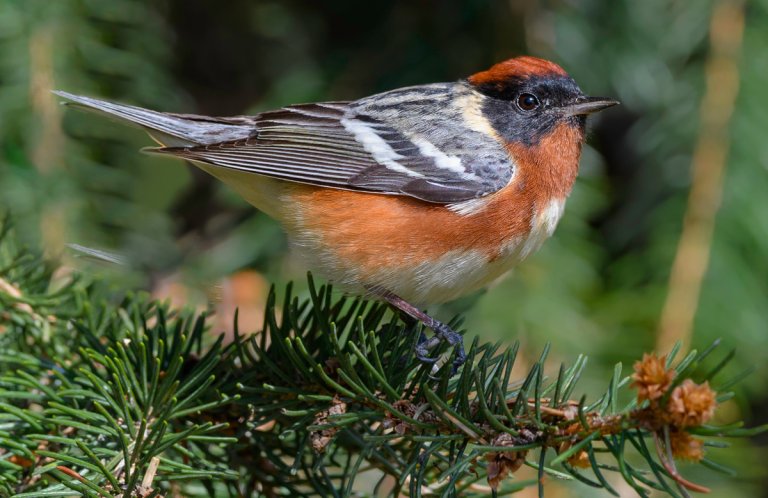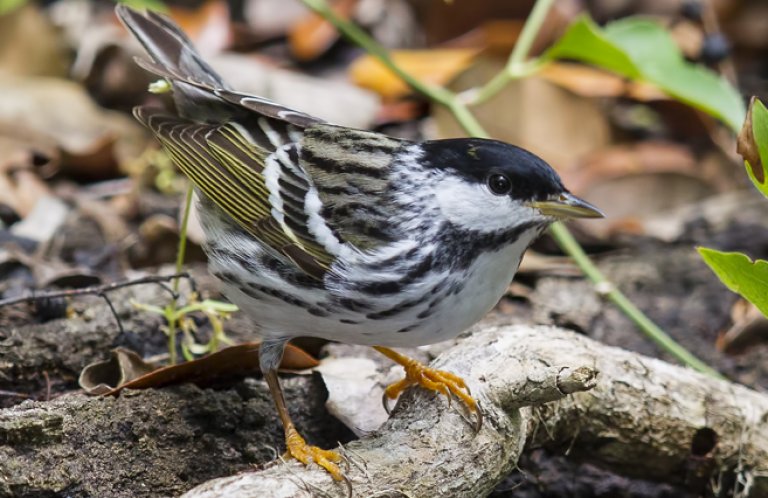About the Connecticut Warbler
To many birders, getting a first glimpse of a Connecticut Warbler starts to seem as challenging as finding a unicorn or Sasquatch. This large warbler breeds in remote areas, winters in Amazonia, and always keeps under thick, low cover, quietly walking on the ground or over low branches. If seen well, the Connecticut Warbler is relatively easy to identify, with its dark head, complete white eye ring, and all-yellow underparts.
Unlike many other Neotropical migrants, including the Chestnut-sided and Bay-breasted Warblers, Connecticut Warblers usually turn up in different regions during spring and fall migration.
Elliptical Migrant
The Connecticut Warbler's genus name Oporornis means "autumn bird" in Greek. This name sprung from the bird's presence along the East Coast only in fall, when the first specimens were documented in the 1800s. (The first-described individual was collected in Connecticut.) It's now known that the Connecticut Warbler is a "spring bird" along a very different pathway — and that it follows what is called an elliptical migration pattern. In fall, adults and immature birds transit south across much of the East Coast, then jump off for trans-oceanic flights, headed for South American wintering grounds, often via an island stopover in the Greater Antilles. In spring, however, returning birds move up the Mississippi Flyway in the U.S. interior. Other birds known to have an elliptical migration pattern include the American Golden-Plover and the Blackpoll Warbler, which is the only other North American warbler species known to winter in the Amazon Basin.
Songs and Sounds
On its breeding grounds, the Connecticut Warbler sings a distinct and penetrating song that signals the bird's presence, yet still challenges observers to actually see the often-concealed singer. The rich song sounds somewhat like: "TuppaWEECHIT TuppaWEECHIT TuppaWEECHIT" or "TuppaWEECHER TuppaWEECHER TuppaWEECH."
Listen here:
Breeding and Feeding
A Grounded Nester
The Connecticut Warbler often nests in remote areas, and many aspects of its breeding biology remain a mystery. Males begin singing and staking out territories in late May, right after they arrive on breeding grounds. Most nesting has been reported in June, and this species raises only one brood per season. The Connecticut Warbler usually nests on the ground, in a cup nest made of dry grasses, leaves, and rootlets, and lined with finer materials including plant fibers and fur.

Little is known about nest construction in this species, and whether one or both parents take part. The nest is often placed in a small forest opening, hidden within thick undergrowth at the base of small trees, shrubs, or brambles, and, in many areas, is further concealed by sphagnum moss. The female incubates the four or five eggs. In Quebec, a female was recorded incubating for 11 days. Young in several Quebec nests fledged eight days after hatching. Recent study has confirmed that both males and females take part in brooding and feeding their young, with each gender performing these duties in different ways. For example, the female broods at night. Once they fledge, young birds tag along with their parents for an additional two weeks.
The Connecticut Warbler forages on the ground and along low branches and logs. It is sometimes seen higher in small trees such as willows. Much remains to be learned about this bird's diet, but on the breeding grounds, Connecticut Warblers feed on a variety of insects and spiders, some snails, and some berries and seeds.
Region and Range

The Connecticut Warbler nests in boreal forest and bog edges across a large inland swath of southern Canada, and also in northern Minnesota, Wisconsin, and Michigan (primarily in the state's Upper Peninsula). In the western part of the breeding range, nesting takes place in drier upland aspen woodlands. This species' winter distribution is still poorly mapped, but from October to April it has been found in part of the lower Amazon Basin in southwestern Brazil and in a band across central Bolivia, where it has been reported not only in forested habitats but also in dense dry scrub.
During migration, Connecticut Warblers often turn up at densely vegetated habitat edges, such as where forest meets meadow or wetland — areas thick with low shrubs and stands of goldenrod and other tall forbs. This bird is considered a very rare migrant in Central America and is also rarely observed in the West Indies. The paucity of reports in these areas is likely due in part to the difficulty of spotting this skulky bird. Recent tracking studies found birds undertaking a two-step fall migration path, stopping in the Greater Antilles (often in October) and then reaching South American wintering grounds in November.
Conservation
A Deep Dive
In 2016, the conservation consortium Partners in Flight estimated that the Connecticut Warbler population declined by 60 percent between 1970 and 2014. In 2019, the organization reported the species was undergoing a large and serious decline. In 2018, a 15-percent drop was estimated over the prior decade.

Help support ABC's conservation mission!
In 2023, the combination of warming temperatures and drought fueled one of the worst fire seasons ever in Canada's boreal forest belt, no doubt contributing at least short-term to the species' challenges. Meanwhile, boreal breeding grounds and South American wintering habitats are also at risk from habitat loss.
Like all warblers, Connecticut Warblers migrate principally at night, when they risk collision with brightly lit communications towers and buildings.
Canada has taken steps to protect large areas of its boreal forest, habitat for the Connecticut Warbler and other species dependent on these lands, including the Canada Warbler, Swainson's Thrush, and Rusty Blackbird. In addition, forest management practices that also benefit boreal forest nesting songbirds will be needed to ensure a turnaround for this enigmatic species. As mentioned above, further study of the Connecticut Warbler's life history is needed, and will be key to setting a sound foundation for this songbird's conservation into the future.
Get Involved
Policies enacted by the U.S. Congress and federal agencies, such as the U.S. Fish and Wildlife Service, have a huge impact on U.S. birds. You can help shape these rules for the better by telling lawmakers to prioritize birds, bird habitat, and bird-friendly measures. To get started, visit ABC's Action Center.
Living a bird-friendly life can have an immediate impact on the birds around you. Doing so can be as easy as adding native plants to your garden, avoiding pesticides, and keeping cats indoors. To learn more, visit our Bird-Friendly Life page.
American Bird Conservancy and our Migratory Bird Joint Venture partners have improved conservation management on more than 8.5 million acres of U.S. bird habitat — an area larger than the state of Maryland — over the last ten years. This is a monumental undertaking, requiring the support of many, and you can help by making a gift today.
























































